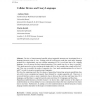Free Online Productivity Tools
i2Speak
i2Symbol
i2OCR
iTex2Img
iWeb2Print
iWeb2Shot
i2Type
iPdf2Split
iPdf2Merge
i2Bopomofo
i2Arabic
i2Style
i2Image
i2PDF
iLatex2Rtf
Sci2ools
FUIN
2007
2007
Cellular Devices and Unary Languages
Devices of interconnected parallel acting sequential automata are investigated from a language theoretic point of view. Starting with the well-known result that each unary language accepted by a deterministic one-way cellular automaton (OCA) in real time has to be a regular language, we will answer the three natural questions ‘How much time do we have to provide?’ ‘How much power do we have to plug in the single cells (i.e., how complex has a single cell to be)?’ and ‘How can we modify the mode of operation (i.e., how much nondeterminism do we have to add)?’ in order to accept non-regular unary languages. We show the surprising result that for classes of generalized interacting automata parallelism does not yield to more computational capacity than obtained by a single sequential cell. Moreover, it is proved that there exists a unary complexity class in between the real-time and linear-time OCA languages, and that there is a gap between the unary real-time OCA languages and...
Related Content
| Added | 14 Dec 2010 |
| Updated | 14 Dec 2010 |
| Type | Journal |
| Year | 2007 |
| Where | FUIN |
| Authors | Andreas Klein, Martin Kutrib |
Comments (0)

